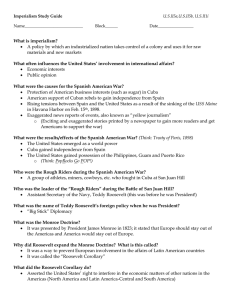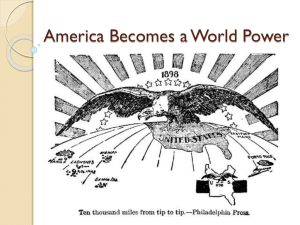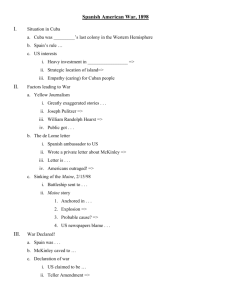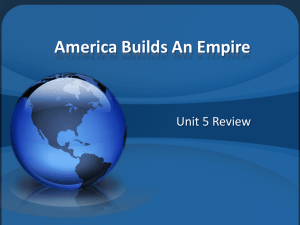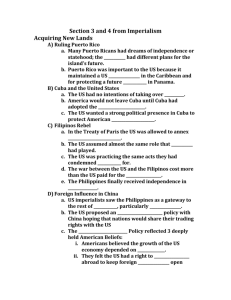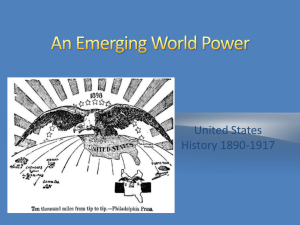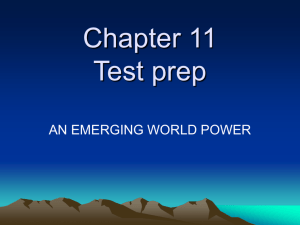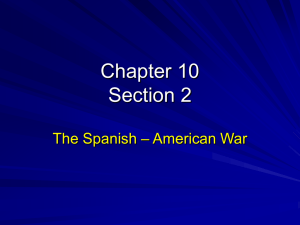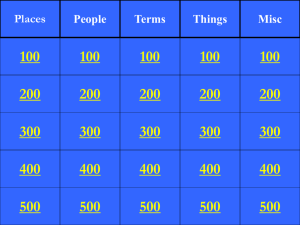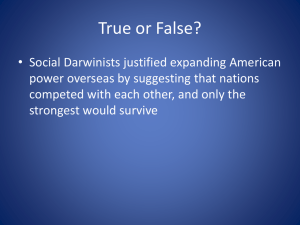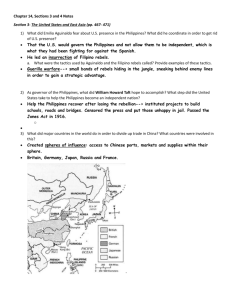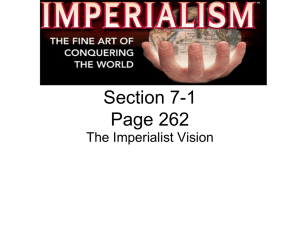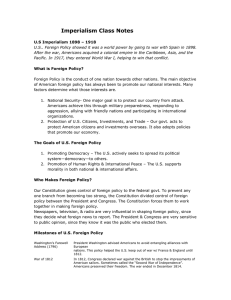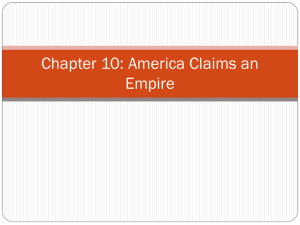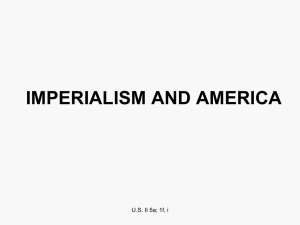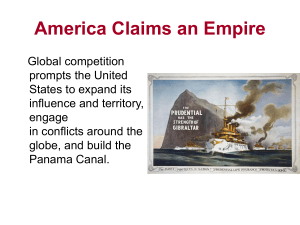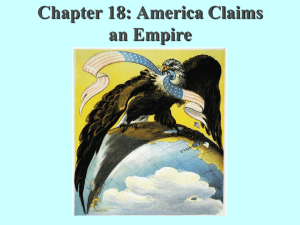Chapter 19 Foreign Policy: Setting a Course of Expansionism
advertisement
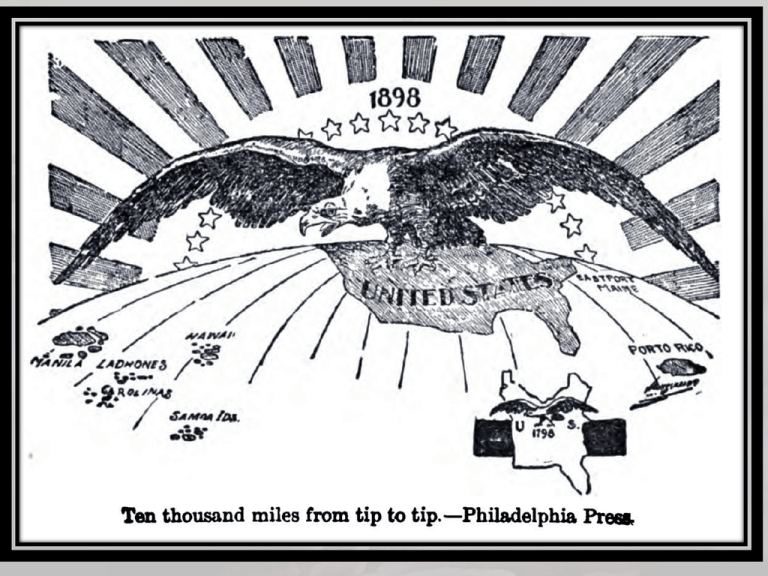
Trouble in Cuba • One of only two remaining Spanish colonies – Much American investment in sugar plantations amid political instability – Two previous rebellions for independence had failed • Valeriano Weyler was sent to put down the rebellions – Created prison camps (“reconcentration camps”) – Thousands die in these overcrowded, unsanitary, poorly equipped camps • Realistically, the U.S. must protect investments and property • Idealistically, the U.S. must help the Cubans realize their noble dream of independence and freedom • President William McKinley hoped to remain neutral. Imperialism, The Role of the Media and a Call to War with Spain • Newspapers – Joseph Pulitzer and the New York World versus William Hearst and the New York Journal • Yellow journalism = sensational exaggerated news stories Causes of the Spanish-America War • The DeLome Letter – Enrique Dupuy DeLome: Spanish ambassador • Describes President McKinley as “weak and catering to the rabble, and, besides, a low politician.” • Outrage and indignation in the United States • “Remember The Maine!!” – February 15, 1898 the American battleship blows up – Probably not a mine, probably not sabotage… remember “yellow journalism”? Causes of the Spanish-America War Congress Declares War! • McKinley hoped to avoid war • Demands that Spain… – Close the camps – Grant Cuba independence – Spain agrees to close the camps, will not grant independence • April 25, 1898 – Congress formally declares war on Spain A “Splendid Little War” with Spain • Teller Amendment – When Cuba is liberated and peace restored, the United States will “leave the government and control of the Island to its people.” • First, the Philippines (another Spanish colony) – Emilio Aguinaldo had been fighting against the Spanish there – Commodore Dewey storms Manila Bay – Aguinaldo with American reinforcements takes Manila A “Splendid Little War” with Spain • Then Cuba – The First U.S. Volunteer Cavalry • The Rough-Riders led by Teddy Roosevelt • After taking San Juan Hill the war went quickly • Peace on August 12 (war was declared in April) – Armistice (cessation of hostilities) • 5500 died mostly from disease (malaria and yellow fever) • Poorly equipped, poorly supplied troops (wool uniforms in the tropical jungle!) win America’s first overseas war America on the World Stage • Treaty of Paris 1898 – Independence to Cuba – Puerto Rico and Guam ceded to the U.S.A. – Philippines to the U.S. with a payment to Spain of $20,000,000 • Platt Amendment states that the U.S. is allowed to intervene in Cuban affairs and to buy or lease naval bases there – By 1913, 60% of Cuba’s land was owned and controlled by U.S. business interests The Foreign Policy of Teddy Roosevelt • American national interests come first • Roosevelt- “Speak softly and carry a big stick; you will go far” • Big Stick Policy- Roosevelt’s strong arm approach in working quietly and patiently to achieve goals overseas but using force if necessary. • Roosevelt Corollary to the Monroe Doctrine – The United States would act as international police power to preserve peace and order in the western hemisphere and protect American interests. Panama • The US helped Panama overthrow Columbia in 1903 and recognized them as an independent nation. • The U.S. builds a 51 mile canal in ten years which connected the Atlantic and Pacific Oceans • Panama Canal (opened 1914) • The Canal was the engineering feat of the time. In 1999 the US returned ownership of the canal back to Panama. Puerto Rico • After the Sp-Am War the U.S. set up a military government, schools, and a postal service • Jones Act (1917): Wilson made Puerto Rico a U.S. territory but still no rights • Puerto Rico remains a U.S. commonwealth – Control over their laws and finances but decisions on defense and tariffs are America’s Philippines • After the Spanish-American War, Filipino Emilio Aguinaldo called for independence from the U.S. • February 1899, fighting broke out between U.S. and Philippines – Hundreds of thousands of soldiers put down the revolt and defeated the Filipino army • The U.S. set up a central government , built schools and controlled the Philippines until 1946. America on the World Stage • Does the Constitution follow the flag? – No: In the Insular Cases the Supreme Court rules that the Filipinos and the Puerto Ricans are subject to American rule but do NOT enjoy American rights Uncle Sam and People from His Colonies, Postcard, ca. 1900 China’s “Open Door” • China was a huge nation rich in resources • Spheres of Influence – areas in which a single nation controlled trading rights • Open Door Policy – issued by the U.S. in 1899 stating that foreign nations must allow free trade in China (issued by Secretary of State John Hay) The Boxer Rebellion in China • This group led an insurrection (rising up to expel the foreign devils) • Thousands killed including Christian missionaries and Chinese Christians • Forces from the U.S., Japan and Europe crush the uprising A new “yellow peril”? • Remember the Chinese Exclusion Act? • Japanese immigrants begin to head to the U.S. – They are met with hatred and suspicion eventhough their numbers were small • “Gentlemens’ Agreement” – Japan agrees secretly to slow down the influx of Japanese laborers in exchange for fairer treatment • This leads to the Root-Takahira Agreement – Each side will respect the Pacific holdings of the other – Each will uphold the Open Door in China TR on the World Stage • Roosevelt wins the Nobel Prize – TR negotiates a settlement between Russia and Japan (the Treaty of Portsmouth) • Japan was hoping for an end to the conflict and Russia was not going to hold on forever
